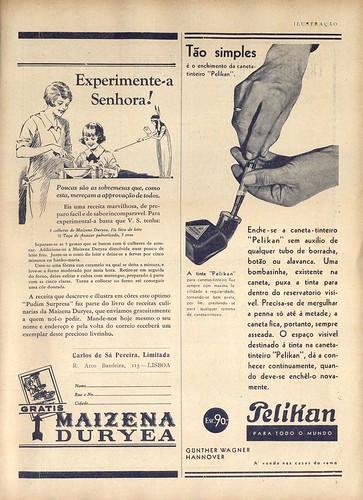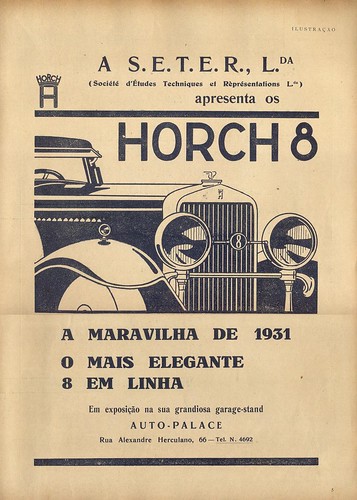Click image for 1095 x 1509 size.
Ad for Maizena Duryea, and Pelikan pens and inks.
Wednesday, June 30, 2010
Ilustração, No. 120, Christmas, December 16 1930 - 8
Help needed to rebuilt the San Antonio school
Excerpt from Mayan Families:
Dear Friends,
I have just had a visit from Lic. Juan Carlos who is the head of the Education dept.here in Solola.
He is asking for help to build a school in San Antonio.
One school is unable to be used because it was right in the pathway of the mud slides.
There has been a lot of damage. They have climbed above it and there are some huge boulders that could come down on it so they don't want to re build it.
The other school is o.k. but it also was in the path of a mud slide probably during Stan.
One school has 504 students . The other school has 560 students.
They have decided at present that all the students will use the one school .
They will go for three hour sessions only so that all the children will have a chance.
They have been given a piece of land that is 20 x 20 meters. It is flat and in a good location , apparently near the cemetery.
This is where they want to build a new school.
They are asking for help with materials and with one builder. There are 47 school teachers who are willing to work voluntarily on the building.
They don't want to wait for help that is supposed to come from the govt. because they feel that they don't know when or if it will come.
They are willing just to make a very long building out of tin sheeting and then break the rooms up depending on how many rooms in each grade.
The other option is that they can build second floor on the school that is still standing.
This school is made like a flight of steps. There is one floor, then the second floor built further in and then the third floor built even further back. I hope you understand my description. One classroom already has a cement roof so a second classroom could be built easily on that. The other two classrooms have tin sheeting roof and would have to have cement lay ed on the roof to be able to build the classrooms.
If you have a club or a school or a church that would like to help with the rebuilding of this school please consider approaching them. It doesn't have to be the total amount. Which they expect will be something like $20,000. If we get this amount we could start building in block rather than tin.
If you would just like to make a personal donation towards the school that would also be greatly appreciated.
Any amount will help them get started.
Thanks, Sharon
www.mayanfamilies.org
http://mayanfamilies.org/DonateOnline
(... more)
Dear Friends,
I have just had a visit from Lic. Juan Carlos who is the head of the Education dept.here in Solola.
He is asking for help to build a school in San Antonio.
One school is unable to be used because it was right in the pathway of the mud slides.
There has been a lot of damage. They have climbed above it and there are some huge boulders that could come down on it so they don't want to re build it.
The other school is o.k. but it also was in the path of a mud slide probably during Stan.
One school has 504 students . The other school has 560 students.
They have decided at present that all the students will use the one school .
They will go for three hour sessions only so that all the children will have a chance.
They have been given a piece of land that is 20 x 20 meters. It is flat and in a good location , apparently near the cemetery.
This is where they want to build a new school.
They are asking for help with materials and with one builder. There are 47 school teachers who are willing to work voluntarily on the building.
They don't want to wait for help that is supposed to come from the govt. because they feel that they don't know when or if it will come.
They are willing just to make a very long building out of tin sheeting and then break the rooms up depending on how many rooms in each grade.
The other option is that they can build second floor on the school that is still standing.
This school is made like a flight of steps. There is one floor, then the second floor built further in and then the third floor built even further back. I hope you understand my description. One classroom already has a cement roof so a second classroom could be built easily on that. The other two classrooms have tin sheeting roof and would have to have cement lay ed on the roof to be able to build the classrooms.
If you have a club or a school or a church that would like to help with the rebuilding of this school please consider approaching them. It doesn't have to be the total amount. Which they expect will be something like $20,000. If we get this amount we could start building in block rather than tin.
If you would just like to make a personal donation towards the school that would also be greatly appreciated.
Any amount will help them get started.
Thanks, Sharon
www.mayanfamilies.org
http://mayanfamilies.org/DonateOnline
(... more)
Hurricane Agatha at Lake Atitlan, Guatemala
Take a look at some of the effects Hurricane Agatha via my flickr photos:
www.flickr.com/photos/catherinetodd/sets/
Plus a video from Jaibalito, another village around the lake:
http://www.youtube.com/watch?v=loyOH13I6vI
Read about the aftermath of Hurricane Agatha, and send donations for economic, education and health projects around Lake Atitlan: www.MayanFamilies.org and www.AmigosdeSantaCruz.org
We need a comprehensive sewer and septic system, population control, environmental practices, Onil Stoves, education, medical treatment and safe living conditions for everyone living around the lake. How can we accomplish all this?
Please comment with your ideas and send donations to the groups mentioned above.
Hurricane Agatha, Lake Atitlan, Jaibalito, Panajachel, Guatemala
www.flickr.com/photos/catherinetodd/sets/
Plus a video from Jaibalito, another village around the lake:
http://www.youtube.com/watch?v=loyOH13I6vI
Read about the aftermath of Hurricane Agatha, and send donations for economic, education and health projects around Lake Atitlan: www.MayanFamilies.org and www.AmigosdeSantaCruz.org
We need a comprehensive sewer and septic system, population control, environmental practices, Onil Stoves, education, medical treatment and safe living conditions for everyone living around the lake. How can we accomplish all this?
Please comment with your ideas and send donations to the groups mentioned above.
Hurricane Agatha, Lake Atitlan, Jaibalito, Panajachel, Guatemala
Maya Arts and Crafts of Guatemala: Artes & Artesanias Mayas de Guatemala
Take a look at this very interesting website:
www.terraexperience.com/Classroom_Teachers_Resources_Kits_Guatemala_Mayan_Culture.htm
Marilyn Anderson, author of Maya Arts and Crafts of Guatemala: Artes & Artesanias Mayas de Guatemala has just completed teachers and parents Guides for using the coloring book. If you want to teach about Mayan Culture or Fair Trade in your Art, Spanish, World History, Geography or other class its a great supplement to your curriculum and can help you prepare lesson plans. The guides are also just a fun way to share with your favorite young children. The guides are available for free on the web - check them out by clicking the links below:
KIDS & FAIR TRADE
LEARNING FROM THE MAYA
(... more)
www.terraexperience.com/Classroom_Teachers_Resources_Kits_Guatemala_Mayan_Culture.htm
Marilyn Anderson, author of Maya Arts and Crafts of Guatemala: Artes & Artesanias Mayas de Guatemala has just completed teachers and parents Guides for using the coloring book. If you want to teach about Mayan Culture or Fair Trade in your Art, Spanish, World History, Geography or other class its a great supplement to your curriculum and can help you prepare lesson plans. The guides are also just a fun way to share with your favorite young children. The guides are available for free on the web - check them out by clicking the links below:
KIDS & FAIR TRADE
LEARNING FROM THE MAYA
(... more)
Illustration and Cartooning
It's hard to believe how high the standards in popular arts were just a few decades ago.Top Tier CartooningGreat IllustrationSomeone Who Can Do BothA Hilarious CombinationGreat Cartooning, Draftsmanship and Design CombinedThese all came from one generous blogger.http://goldenagecomicbookstories.blogspot.com/
FSF photoshoot in the Netherlands!

FSF is coming to the Netherlands to be a part of the amazing annual Street Science event put on by Hip Hop Huis, along with the Worldl BBoy Classic. It's gonna be off the hook!
For more info on the big event, check streetscience.nl and hiphophuis.nl
If you're interested in being a part of the photoshoot, we'll have more info coming your way soon!
Or contact us at photoshoot@femalesneakerfiend.com.
Tuesday, June 29, 2010
Ilustração, No. 120, Christmas, December 16 1930 - 6
Click image for 1077 x 1506 size.
Horch 8 ad.
Labels:
1930s,
advertising,
car,
Illustration,
Ilustração,
magazine,
Portugal,
Portuguese
More Hair : Asian Girls
My "realistic" drawings are about as bland as bland can be. I'm ready for when Filmation starts up again. My goal is not to learn to draw realistically, but to understand why things look a certain way in general logical terms so I can then simplify and cartoon them.I gave myself a double problem with these studies. I want to add some hairstyles to my pretty girl palette and am using a Japanese
Nike Varsity Destroyer Women’s Jacket

Are you tired of buying small men's sizes on the clothes you like? Yep, most of us agree with that. Nike has just released a new colorway of the women’s version of the Varsity Destroyers Jacket. This jacket is cut slimmer to fit the ladies, and comes with the same details as the men's jacket, for example the accents on ribbed cuffs, collars and logo patches.

Now that they've started down this lovely road, please, more colorways!
Available now at Schuh-You.
Our house is a very, very, very fine house
We saw a house for sale way back in November that we loved. We went to see it with our realtor in December and put an offer on it then and there. Although it was a short sale we were willing to wait because we really, really loved it. It was 3500 square feet in a subdivision in a great part of town.
Also in December we sold our house to my parents (they got three foster kids and their little two bedroom “retirement” home wasn’t going to cut it anymore). We lived at my bother’s house in January and February while he was working out of town. Then we moved into an apartment in March, where we continue to live now. Over the past month, my husband and I have been very frustrated with the whole buying process. Banks don’t have to follow any timelines when selling a house as a short sale. And something just seemed fishy about our case. It had gone through three different adjusters before the file was finally wrapped up and headed to the board for a vote. That was supposed to happen four weeks ago and we still haven’t heard anything. So last week, we gave up. We need a house and we’ve waited too long for this one. It just didn’t seem like our offer was going to be accepted anymore. And even if it was, the bank could take it back up until the day before closing if a better offer came along or if they changed their mind. We aren’t willing to take that risk and waste more time. So we pulled our offer. It just wasn't meant to be.
Now we’re moving forward with Plan B: building the exact same house on a half acre lot in the next town over. Although I wasn’t thrilled at first about living there, I really do love the house and since it’s huge lot, we won’t feel claustrophobic in the subdivision. Plus, it’s across the street from a really nice golf course, so it’s in a quiet area with lots of trees, walking trails and no traffic. My husband has a few co-workers who live there now and they have nothing but good things to say about it. I've always wanted to live in a neighborhood where Nolan can play outside with his friends all day and ride his bike in the street, just like I did as a kid.
Also, when I go back to work in a few years, I’ll most likely be working in that city again. I was a paralegal and it’s where our Superior Court is located as well as 80% of the county’s law firms. My husband’s morning commute will be a piece of cake because he is a supervisor and works earlier than most people. His afternoon commute will be a little longer because of traffic, but it won’t be any different than if we moved to that first house. Plus, he teaches at his gym twice a week, so he'll miss the evening traffic altogether.
We signed all the paperwork last week and got to design the inside by picking out our carpet, floors, cabinets, counters, paint color, molding, light fixtures, sinks, showers, etc. Fun! Although the house won’t be ready until late October, we’re so happy and excited that we finally have a plan. This apartment living is driving me crazy. There’s a reason I haven’t done it since college! This is our lot:
And look, we already have a neighbor.
'MODELOS PARA ARMAR' THINKING LATIN AMERICA FROM THE MUSAC COLLECTION

Prologue: the structure of survival: a favela house, a volkswagen, a pool of blood...



Meyer Vaisman, 'Verde por fuera, Rojo por dentro', 1995, reconstruction of his parents dressing room inside a favela house

Damian Ortega, This is Not a Citroen DS


Jorge Macchi, 'Un Charco de Sangre', a pool of blood, cut outs from tragedy newspapers...

Maria Teresa Hincapie, 'Una Cosa es una Cosa', 1990/2005, video documentation of a performance in which she creates a labyrinth with her possesions

Julieta Aranda, 'There has been a Miscalculation (Flattened Amunition), 2007, 100 pulverized science fiction novels written between 1870 and 2007, a compressor blows up the dust at random intervals...

Pedro Reyes, screen

Teresa Margolles, narco jewelry


Ana Mendieta


Luis Camnitzer's viewer and kaleidoscopic view from the viewer, installed at different locations in the exhibition

Alexander Apostol, Caraca's favelas houses with windows erased...

Andreas Angelidakis, architect of the exhibition's architecture/display






Fernando Bryce drawings based on documents on European colonization

Erik Beltran's diagram


video cabins and the temple/pyramid for Leonilson's drawings


Leonilson, 'His Interior Protector Mountain', drawing on top of the pyramid...

Martin Sastre's video


Mario Garcia Torres, 'Moonwalk' on Rigo Tovar being the first moonwalk dancer...

Melanie Smith and Rafael Ortega's film, filmed at Salon Covadonga in Mexico City



Carla Zaccagnini's rubber stamps on found stories on Leon's newspaper, stamped on all printed material coming from the museum


Valeska Soares


Rivane Neuenschwander's calendar, 31 tables with collected found papers with the date number on it


Gilda Mantilla and Raimond Chaves' drawing room





Raimond Chaves and Gilda Mantilla's drawings

Caio Reisewitz landscape photographs next to Luis Camnitzer's viewer


avaf mural with video homage to Los Super Elegantes

tropical garden behind the exhibition's escenography


Carlos Amorales


Diango Hernandez

Carlos Garaicoa's construction of a city's nightscape

Matias Duville, wall drawing

Federico Herrero's painting

Federico Herrero's mural in MUSAC's patio




Carla Zaccagnini and Federico Herrero, live sculptures

Gran Colombian Combo: artist Raimond Chaves, Andrea Echeverri, Musac curator Maria Ines Rodriguez, Hector Buitrago!

Hector Buitrago and Andrea Echeverri, 'Los Aterciopelados' in concert

Andrea Echeverri with cheverista flag

Los Aterciopelados concert outside MUSAC

and next day Cheverista Internacionale brunch at Maria Ines...
MODELOS PARA ARMAR:
Thinking Latin America from the MUSAC Collection
Artists: Carlos Amorales , Alexander Apóstol, Julieta Aranda, AVAF, Fernando Bryce, Erick Beltrán, Iñaki Bonillas, Tania Bruguera, François Bucher, Luís Camnitzer, Raimond Chaves, José Damasceno, Dr. Lakra, Matías Duville, Sandra Gamarra, Carlos Garaicoa, Mario García Torres, Diango Hernández, Juan Fernando Herrán, Federico Herrero, María Teresa Hincapié, Leonilson, Jorge Macchi, Gilda Mantilla, Gilda Mantilla y Raimond Chaves, Teresa Margolles, Hernán Marina, Ana Mendieta, Mujeres Creando, Óscar Muñoz, Rivane Neuenschwander, Damián Ortega, Álvaro Oyarzun, Nicolás París, Jorge Pineda, Caio Reisewitz, Rosângela Renno, Pedro Reyes, Miguel Ángel Rojas, Martín Sastre, Melanie Smith y Rafael Ortega, Valeska Soares, Javier Téllez, Meyer Vaisman , Carla Zaccagnini.
Curators: Agustín Pérez Rubio, María Inés Rodríguez, Octavio Zaya
Exhibition design: Andreas Angelidakis
Venue: Galleries 1, 2, 3, 4, 5 & 6, MUSAC
Dates: 26 June 2010 – 9 January 2011
From 26 June 2010 to 9 January 2011, within its 5th Anniversary programme, the Museo de Arte Contemporáneo de Castilla y León will be devoting its entire exhibition space to a major exhibition displaying most of the pieces by over 40 Latin American artists held in the MUSAC Collection. Under the title MODEL KITS. Thinking Latin America from the MUSAC Collection, the show curated by Agustín Pérez Rubio (MUSAC Director), María Inés Rodríguez (MUSAC Head Curator) and Octavio Zaya (MUSAC curator at large), invites viewers to trace their own course through contemporary Latin American art, over a layout designed by architect Andreas Angelidakis. In parallel, all activities scheduled at MUSAC between June 2010 and January 2011 will focus on Latin America, including new projects at Laboratorio 987 and the Showcases, artist workshops, publications, seminars, performances, concerts, etc.
MODEL KITS. Thinking Latin America from the MUSAC Collection draws its inspiration from 62/ A Model Kit, a novel published by Julio Cortázar in 1968, which stands as one of the most enduringly original and ambitions projects in Spanish-language literature. Translating it into a different period and discipline, the exhibition modestly attempts to apply the unique novel's vision in the way it rejects and subverts any single interpretation or conventional linear narrative of the works on display, challenging the viewer to establish her own parameters and directions, connections and relationships. MODEL KITS includes around 100 works by over 40 Latin American artists, produced since the late 1980s (under the MUSAC Collection's purchasing criteria), covering a broad range of media and languages, artistic strategies and significations, references, objects and situations, which jointly contribute to assembling varying narratives and permutations. From leading deceased artists who hold pride of place in Latin American Art History like Ana Mendieta, Leonilson or Maria Teresa Hincapié; to great masters such as Luis Camnitzer, Oscar Muñoz or Miguel Angel Rojas; the landmark 90s generation of Valeska Soares, Rosângela Renó, Jorge Macchi or Carlos Garaicoa; all the way to young artists who are making their mark on the current landscape, such as Mario García Torres, Julieta Aranda or Matías Duville, amongst others.
MODEL KITS challenges the viewer to take the part of an active and liberated reader who writes her own score, creating a new narrative. Under this perspective, the exhibition's varied elements can be combined and analyzed according to the concerns and references each viewer brings to bear. The exhibition does not therefore adhere to a central theme or nucleus around which to develop a privileged narrative. While it may be said that the works' diverse perspectives and languages reflect a critical perspective on society and its relationships with other contexts, the exhibition brings together discourses and approaches that are personal and philosophical, urban and political, literary and artistic, etc., to the point that they cover each and every one of the undercurrents defining contemporary art as it is made anywhere in the world, whether it be Paris, Tokyo, Ohio or Bogota. In this sense, the exhibition is projected as an infinite 'ars combinatoria', not limited to the featured artists' Latin American geographical and cultural sphere, but aspiring to establish varying and contrasting readings and conclusions, wavering patterns and ambiguous hints, unresolved questions and diverging paths, like a labyrinth with no exit.
Reality and fiction, surprise and mystery, humour and pain go hand in hand, setting a pace marked by a set of events in no specific order, defined alternatively by logic or by intuition; by action or by contemplation; by the material or the spiritual. In its diversity, the exhibition invites us to think of Latin America as a project in progress, laden with endless possibilities; a project with no constraints in space or time, multifaceted and open to different worlds; a project that expresses its artistic interest in what is shared and collective through 'singularity' as opposed to identity. A model kit waiting to be assembled.
http://www.musac.es
Subscribe to:
Comments (Atom)




